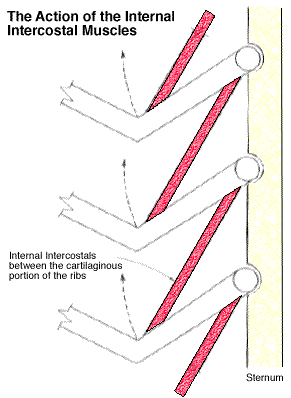The Action of the Internal Intercostals
The Internal Intercostals muscles run perpendicularly to the External Intercostal muscles. It is important to understand that the intercostals in the front, between the cartilages that connect the rib bones to the sternum, work differently than those muscles that go between the bones further back. These intercartilaginous muscles, pull the ribs up, creating a higher lung volume, drawing air into the lungs. In other words these muscles are inspiratory muscles, just like the extrinsic muscles. Take a look at the schematic

The portion of the image which is in yellow represents where the sternum is. The ribs are white. The red bands are the intercartilaginous internal intercostal muscles (say that fast five times!). As the muscle contracts and shortens, it lifts the rib. You might compare the direction of these muscles to that of the transversus thoracis muscles, visible in the image we saw on the first intercostals page. At this point of the rib, the internal intercostal elevate the ribs while the transversus thoracis depress them.
On the other hand, the intercostal muscles that are between the boney part of the ribs, the interosseous internal intercostal muscles, counteract the action of the external intercostals. That is, when they contract and shorten, the ribs are brought closer together, creating a positive pressure difference between the lung air and the outside air. If the throat is open, the air will rush out (it might even make the vocal folds vibrate - see phonation!). So for the interosseous part...
The internal intercostal muscles are muscles of exhalation!
Back to Respiration
- More on Anatomy
- The Physics of Breathing
- Application to the Performer

